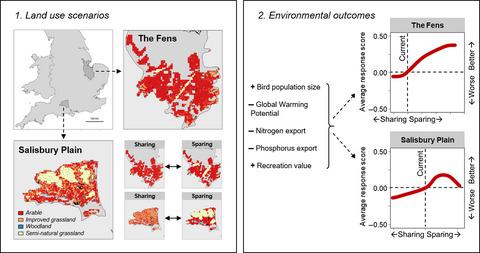当前位置:
X-MOL 学术
›
J. Appl. Ecol.
›
论文详情
Our official English website, www.x-mol.net, welcomes your
feedback! (Note: you will need to create a separate account there.)
Evaluating spatially explicit sharing‐sparing scenarios for multiple environmental outcomes
Journal of Applied Ecology ( IF 5.0 ) Pub Date : 2020-11-15 , DOI: 10.1111/1365-2664.13785 Tom Finch 1, 2 , Brett H. Day 3 , Dario Massimino 4 , John W. Redhead 5 , Rob H. Field 1 , Andrew Balmford 2 , Rhys E. Green 2, 5 , Will J. Peach 1
中文翻译:

评估多个环境结果在空间上明确的共享保留方案
更新日期:2020-11-15
Journal of Applied Ecology ( IF 5.0 ) Pub Date : 2020-11-15 , DOI: 10.1111/1365-2664.13785 Tom Finch 1, 2 , Brett H. Day 3 , Dario Massimino 4 , John W. Redhead 5 , Rob H. Field 1 , Andrew Balmford 2 , Rhys E. Green 2, 5 , Will J. Peach 1
Affiliation

|
- Understanding how to allocate land for the sustainable delivery of multiple, competing objectives is a major societal challenge. The land sharing‐sparing framework presents a heuristic for understanding the trade‐off between food production and biodiversity conservation by comparing region‐wide land‐use scenarios which are equivalent in terms of overall food production.
- Here, for two contrasting regions of lowland England (The Fens and Salisbury Plain), we use empirical data and predictive models to compare a suite of spatially explicit scenarios reflecting the full range of the sharing‐sparing continuum, including mixed scenarios which combine elements of both sharing and sparing. We evaluate a range of outcomes (bird populations, global warming potential (GWP), nitrogen and phosphorus pollution and outdoor recreation), to identify approaches to regional land‐use planning with the potential to deliver multiple societal benefits.
- Land‐sharing scenarios (which reduce the dominance of productive agricultural land in farmed areas and the area of larger unfarmed areas) result in negative outcomes, particularly for birds and GWP. In contrast, many land‐sparing scenarios (including mixed scenarios which increase the area of lower‐yield farmland alongside larger unfarmed areas) resulted in improvements in all or most outcomes, although for recreation and nutrient export differences between scenarios were modest.
- Importantly, environmental outcomes also depended on the spatial arrangement of spared land, the types of natural or semi‐natural habitat promoted on spared land, whether some lower‐yield farmland is delivered alongside larger unfarmed areas, and the overall region‐wide food production target.
- Policy implications. Our study suggests that land‐sparing strategies which increase the area of natural and semi‐natural areas can improve environmental outcomes, despite the costs associated with high‐yield agriculture. However, high‐yield agriculture should not compromise future production or the conservation value of spared land, and explicit policies such as certification or payments for ecosystem services are required to link sustainable high‐yield production to habitat conservation. Our study also highlights the importance of mitigating projected increases in food demand.
中文翻译:

评估多个环境结果在空间上明确的共享保留方案
- 了解如何分配土地以可持续实现多个相互竞争的目标是一项重大的社会挑战。土地共享保护框架通过比较区域范围内的土地利用情景(在总体粮食生产方面是等效的),提出了一种启发式的方法,用于理解粮食生产与生物多样性保护之间的权衡。
- 在这里,对于英格兰低地的两个截然不同的地区(芬斯和索尔兹伯里平原),我们使用经验数据和预测模型来比较一套反映整个共享稀疏连续体的空间显式场景,包括结合了以下要素的混合场景:共享和保留。我们评估了一系列结果(鸟类种群,全球变暖潜能(GWP),氮和磷污染以及户外娱乐),以确定可以产生多种社会效益的区域土地利用规划方法。
- 土地共享的情况(减少了耕作区和较大的非耕作区的生产性农业用地的主导地位)导致负面结果,特别是对鸟类和全球升温潜能值。相比之下,尽管在娱乐和养分出口方面,差异不大,但许多土地节约方案(包括增加低产农田面积和较大的未耕种面积的混合方案)导致了所有或大多数成果的改善。
- 重要的是,环境结果还取决于闲置土地的空间布置,在闲置土地上促进的自然或半自然栖息地的类型,是否在较大的未耕种地区旁边交付了一些低产农田,以及整个区域的整体粮食生产目标。
- 政策含义。我们的研究表明,尽管高产农业成本高昂,但增加自然和半自然地区面积的土地节约策略可以改善环境结果。但是,高产农业不应损害未来的生产或闲置土地的保护价值,因此需要明确的政策,例如认证或为生态系统服务付款,以将可持续的高产生产与栖息地保护联系起来。我们的研究还强调了缓解预计的粮食需求增长的重要性。











































 京公网安备 11010802027423号
京公网安备 11010802027423号